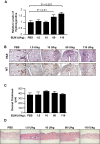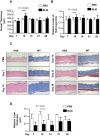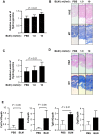Optimization of a murine and human tissue model to recapitulate dermal and pulmonary features of systemic sclerosis
- PMID: 28651005
- PMCID: PMC5484495
- DOI: 10.1371/journal.pone.0179917
Optimization of a murine and human tissue model to recapitulate dermal and pulmonary features of systemic sclerosis
Abstract
The murine bleomycin (BLM)-induced fibrosis model is the most widely used in systemic sclerosis (SSc) studies. It has been reported that systemic delivery of BLM via continuous diffusion from subcutaneously implanted osmotic minipumps can cause fibrosis of the skin, lungs, and other internal organs. However, the mouse strain, dosage of BLM, administration period, and additional important features differ from one report to the next. In this study, by employing the pump model in C57BL/6J mice, we show a dose-dependent increase in lung fibrosis by day 28 and a transient increase in dermal thickness. Dermal thickness and the level of collagen in skin treated with high-dose BLM was significantly higher than in skin treated with low dose BLM or vehicle. A reduction in the thickness of the adipose layer was noted in both high and low dose groups at earlier time points suggesting that the loss of the fat layer precedes the onset of fibrosis. High-dose BLM also induced dermal fibrosis and increased expression of fibrosis-associated genes ex vivo in human skin, thus confirming and extending the in vivo findings, and demonstrating that a human organ culture model can be used to assess the effect of BLM on skin. In summary, our findings suggest that the BLM pump model is an attractive model to analyze the underlying mechanisms of fibrosis and test the efficacy of potential therapies. However, the choice of mouse strain, duration of BLM administration and dose must be carefully considered when using this model.
Conflict of interest statement
Figures





Similar articles
-
A modified murine model of systemic sclerosis: bleomycin given by pump infusion induced skin and pulmonary inflammation and fibrosis.Lab Invest. 2015 Mar;95(3):342-50. doi: 10.1038/labinvest.2014.145. Epub 2014 Dec 15. Lab Invest. 2015. PMID: 25502178
-
Mouse model of dermal fibrosis induced by one-time injection of bleomycin-poly(L-lactic acid) microspheres.Rheumatology (Oxford). 2008 Apr;47(4):454-7. doi: 10.1093/rheumatology/ken058. Epub 2008 Mar 3. Rheumatology (Oxford). 2008. PMID: 18316335
-
A mouse model of progressive lung fibrosis with cutaneous involvement induced by a combination of oropharyngeal and osmotic minipump bleomycin delivery.Am J Physiol Lung Cell Mol Physiol. 2024 Jun 1;326(6):L736-L753. doi: 10.1152/ajplung.00408.2023. Epub 2024 Apr 23. Am J Physiol Lung Cell Mol Physiol. 2024. PMID: 38651940 Free PMC article.
-
Skin and lung fibrosis induced by bleomycin in mice: a systematic review.Reumatismo. 2024 Mar 22;76(1). doi: 10.4081/reumatismo.2024.1642. Reumatismo. 2024. PMID: 38523580
-
Animal models of scleroderma: recent progress.Curr Opin Rheumatol. 2016 Nov;28(6):561-70. doi: 10.1097/BOR.0000000000000331. Curr Opin Rheumatol. 2016. PMID: 27533324 Review.
Cited by
-
SSC-ILD mouse model induced by osmotic minipump delivered bleomycin: effect of Nintedanib.Sci Rep. 2021 Sep 16;11(1):18513. doi: 10.1038/s41598-021-97728-z. Sci Rep. 2021. PMID: 34531421 Free PMC article.
-
Self-Assembled Human Skin Equivalents Model Macrophage Activation of Cutaneous Fibrogenesis in Systemic Sclerosis.Arthritis Rheumatol. 2022 Jul;74(7):1245-1256. doi: 10.1002/art.42097. Epub 2022 May 30. Arthritis Rheumatol. 2022. PMID: 35212485 Free PMC article.
-
Human hypofunctional NCF1 variants promote pulmonary fibrosis in the bleomycin-induced mouse model and patients with systemic sclerosis via expansion of SPP1+ monocytes-derived macrophages.Ann Rheum Dis. 2025 Feb;84(2):294-306. doi: 10.1136/ard-2024-226034. Epub 2025 Jan 2. Ann Rheum Dis. 2025. PMID: 39919902
-
Ameliorating Fibrosis in Murine and Human Tissues with END55, an Endostatin-Derived Fusion Protein Made in Plants.Biomedicines. 2022 Nov 9;10(11):2861. doi: 10.3390/biomedicines10112861. Biomedicines. 2022. PMID: 36359382 Free PMC article.
-
Involvement of caveolin-1 in skin diseases.Front Immunol. 2022 Nov 30;13:1035451. doi: 10.3389/fimmu.2022.1035451. eCollection 2022. Front Immunol. 2022. PMID: 36532050 Free PMC article. Review.
References
-
- Almeida I, Faria R, Vita P, Vasconcelos C. Systemic sclerosis refractory disease: from the skin to the heart. Autoimmun Rev. 2011;10(11):693–701. Epub 2011/05/07. doi: 10.1016/j.autrev.2011.04.025 . - DOI - PubMed
-
- Yang IV, Schwartz DA. Epigenetics of idiopathic pulmonary fibrosis. Transl Res. 2015;165(1):48–60. Epub 2014/03/31. doi: 10.1016/j.trsl.2014.03.011 ; PubMed Central PMCID: PMCPMC4182166. - DOI - PMC - PubMed
-
- Wynn TA. Common and unique mechanisms regulate fibrosis in various fibroproliferative diseases. J Clin Invest. 2007;117(3):524–9. doi: 10.1172/JCI31487 ; PubMed Central PMCID: PMCPMC1804380. - DOI - PMC - PubMed
-
- Kalluri R, Sukhatme VP. Fibrosis and angiogenesis. Curr Opin Nephrol Hypertens. 2000;9(4):413–8. . - PubMed
-
- Steen VD, Medsger TA. Changes in causes of death in systemic sclerosis, 1972–2002. Ann Rheum Dis. 2007;66(7):940–4. Epub 2007/02/28. doi: 10.1136/ard.2006.066068 ; PubMed Central PMCID: PMCPMC1955114. - DOI - PMC - PubMed
MeSH terms
Substances
Grants and funding
LinkOut - more resources
Full Text Sources
Other Literature Sources
Medical

